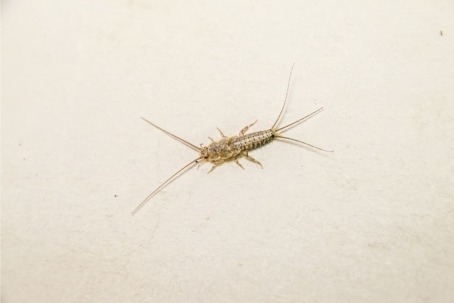Do Bristletails Bite?
Bristletails, which include silverfish and firebrats, are primitive, wingless insects. Despite their somewhat intimidating appearance, they do not bite humans or pets. They lack strong mouthparts capable of breaking human skin. Their mandibles are adapted for chewing soft, starchy materials like paper, glue, fabric, and food crumbs—not flesh.
You might see them nibbling on book bindings, wallpaper paste, or stored grains, but any marks or irritation on skin are usually misattributed to bristletails. Sometimes minor skin irritation can occur if people scratch areas where bristletails have crawled, but this is purely mechanical contact, not a true bite.
There are essentially no situations in which bristletails bite people or pets, and they are considered harmless from a biting perspective. The real concern with them is damage to household items rather than health risks.
Bristletail Bites
Bristletails—including silverfish and firebrats—do not bite humans or pets, so there are essentially no direct risks from bites. Their mouthparts are too weak and specialized for consuming soft, starchy materials, so they cannot penetrate skin.
However, there are a few indirect concerns related to their presence rather than bites:
Allergic reactions – In rare cases, people sensitive to insect scales, feces, or shed skin may experience mild allergic responses such as sneezing, coughing, or skin irritation if bristletails are abundant.
Contamination of food or surfaces – While not biting, bristletails can crawl over stored food, books, or paper, leaving tiny particles that could contribute to bacterial or fungal contamination.
Psychological stress – For some people, a significant infestation can cause anxiety or discomfort, though this is emotional rather than physical harm.
There are no health risks from bristletail bites themselves, because bites simply don’t occur. The main concerns are allergic reactions or property contamination rather than injury.
What Do Bristletail Bites Look Like?
Since bristletails (silverfish and firebrats) do not bite, any marks on the skin attributed to them are not true bites. However, people sometimes mistake other minor skin irritations or scratches from environmental contact for bristletail bites. Here’s what you might observe:
Red, itchy bumps – Often caused by scratching, minor allergic reactions, or other insects (like mosquitoes or bed bugs), not bristletails.
Small scratches or abrasions – If a bristletail brushes against sensitive skin, it might leave a superficial mark, but it’s not a bite.
Clusters of tiny welts – Rarely, some people may develop tiny welts from contact with bristletail scales or fecal matter, but these are uncommon and mild.
There is no puncture wound, bleeding, or true bite mark caused by bristletails. If someone has actual bite-like marks, it’s likely from another pest, such as bed bugs, fleas, or mosquitoes, not silverfish or firebrats.
What To Do About Bristletail Bites
If you think you’ve been bitten by bristletails, the first thing to know is that it’s extremely unlikely that bristletails are responsible, because they cannot bite humans or pets. Any skin irritation or bite-like marks are almost certainly caused by another pest (bed bugs, fleas, mites, mosquitoes, etc.) or by environmental factors such as scratches or allergic reactions. Here’s what to do:
Examine the marks carefully – Look at the pattern, size, and location. True insect bites are often in clusters or lines, whereas environmental irritation or contact with surfaces will be more random.
Clean the affected area – Wash any redness or bumps with mild soap and water to prevent infection.
Relieve itching or irritation – Use over-the-counter remedies such as hydrocortisone cream, calamine lotion, or an oral antihistamine if necessary.
Inspect your environment – Check for other pests such as fleas, bed bugs, or mites, which are far more likely to bite. Look at bedding, pets, furniture, and crevices.
Document the situation – Take photos of the marks and note any patterns in time or location. This can help a professional identify the real culprit.
Consult our professionals if needed – If the marks worsen, persist, or you can’t identify the source, contact our licensed pest control experts to inspect your home. Bristletails themselves don’t require bite treatment, but finding the actual biting pest is crucial.
Treat the skin normally and focus on inspecting for real biting pests, because bristletails are harmless in this regard.

